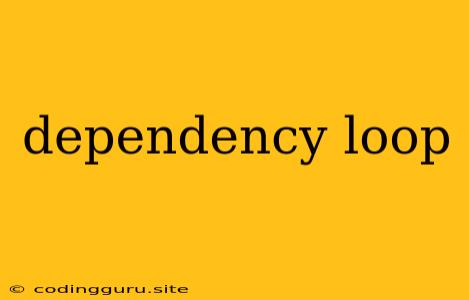Dependency Loop: A Developer's Nightmare
A dependency loop is a dreaded situation in software development where two or more modules depend on each other in a circular fashion. This creates a vicious cycle where each module requires the other to be defined or loaded before it can be used. It's like a game of "who came first, the chicken or the egg?" in the world of software.
This seemingly straightforward concept can lead to a myriad of issues, ranging from compilation errors and unexpected runtime behavior to crashes and a general sense of frustration among developers.
The Root of the Problem: Understanding Dependency Loops
Imagine a scenario where module A depends on module B, and module B depends on module A. This creates a closed loop, and the system can't determine the order in which these modules should be loaded or compiled. This can result in:
- Circular references: The compiler or runtime environment encounters a circular reference, unable to resolve the dependencies.
- Stack overflow errors: When the system tries to resolve the dependencies recursively, it can lead to an infinite loop, eventually exhausting the stack memory and causing a crash.
- Unpredictable behavior: The order of execution may be inconsistent, leading to unpredictable results and making debugging a nightmare.
How to Identify a Dependency Loop
Identifying a dependency loop can be tricky, especially in larger projects. However, here are some common indicators:
- Compiler errors: The compiler might issue error messages related to circular dependencies or unresolved references.
- Runtime exceptions: The program might crash during runtime with errors indicating unresolved dependencies or circular references.
- Unpredictable behavior: Unexpected behaviour or functionality may point towards a dependency loop.
Strategies to Break the Loop
Once you've identified a dependency loop, here are some strategies to break it:
- Refactor the code: The most common and often necessary solution is to refactor the code to eliminate the circular dependency. This might involve:
- Moving shared functionality: Extract common functionality into a separate module independent of the original modules.
- Introducing an interface: Implement an interface that both modules can depend on, breaking the direct circular dependency.
- Changing the design: Completely redesigning the architecture to avoid circular dependencies might be necessary in some cases.
- Use dependency management tools: Tools like npm (for Node.js), Maven (for Java), or Gradle (for Java and other languages) can help manage dependencies and detect potential circular references.
- Utilize a dependency graph: Visualizing the project's dependencies can help identify and understand the circular dependency relationships.
- Implement dependency injection: Using dependency injection, you can pass dependencies to modules instead of relying on implicit circular references.
Examples of Dependency Loops
Let's consider a simplified example of a potential dependency loop in Python:
# Module A
import ModuleB
def function_a():
print("Function A")
ModuleB.function_b()
# Module B
import ModuleA
def function_b():
print("Function B")
ModuleA.function_a()
In this case, Module A imports Module B and calls function_b, while Module B imports Module A and calls function_a. This creates a circular dependency, which could lead to errors.
Conclusion
A dependency loop is a common problem in software development that can lead to various issues. Understanding the causes and identifying potential loops can help you avoid them. Refactoring code, using dependency management tools, and implementing dependency injection are effective strategies to break the cycle. By addressing dependency loops early on, you can ensure a smoother development process and avoid future headaches.
